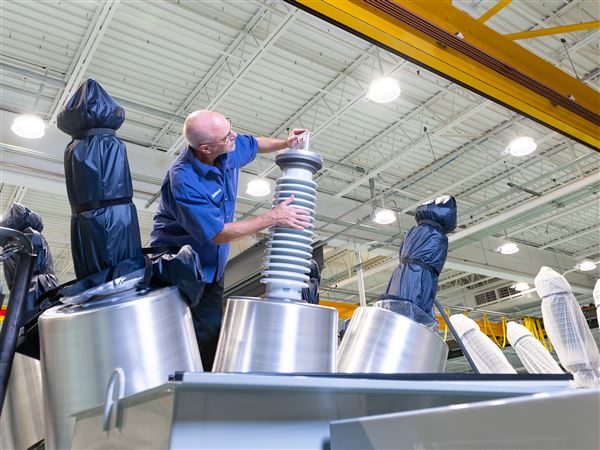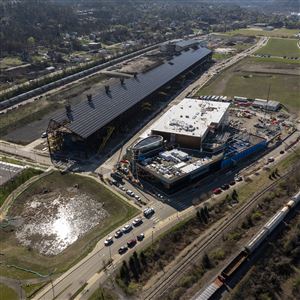While visitors to this week's Three Rivers Arts Festival anxiously scanned weather forecasts, a 3-D scanner was giving Alexander Merkviladze's face a quick, but thorough, going over.
Mr. Merkviladze works for Artec Group, a Russian manufacturer of scanners that create digital images of objects. The images end up in 3-D printers that, much like inkjet printers, produce objects made of metals, plastic, concrete and other materials.
Artec and Exact Metrology, a Cincinnati company that sells Artec's 3-D scanners, were among 150 companies exhibiting at a three-day conference at the David L. Lawrence Convention Center sponsored by the Society of Manufacturing Engineers. The conference showcased the latest technology in the field of additive manufacturing -- the catch-all phrase for using 3-D images, software and printers to design and manufacture a wide range of consumer and industrial products.
About 2,500 people attended, up from about 1,500 at last year's event, said the society's Debbie Holton. More than 100 came from overseas. "We've seen a little more of an international audience this year, specifically from Asia," Ms. Holton said.
The jump in attendance is indicative of the widespread interest in additive manufacturing, which many are calling the next industrial revolution. In addition to manufacturers and educators who are using the technology to teach 3-D modeling and other topics, investors and financial analysts flocked to the show to gain a better understanding of what has made 3-D printing stocks among Wall Street's best performing sectors.
The ExOne Co., a North Huntingdon maker of 3-D printers, has helped fuel that trend. Since going public at $18 per share in February, ExOne shares have more than doubled, closing Wednesday at $48.97.
President and chief operating officer David Burns said ExOne hosted a luncheon Tuesday for 50 investors and investment firms who attended the conference and were interested in learning more about the company.
Back on the floor of the convention center, the company's staffers were overwhelmed by attendees who stopped by its booth.
"We clearly had more people here yesterday than we could handle," Mr. Burns said Wednesday.
There is something about the technology that interests everyone from industrial giants such as General Electric and Boeing to the medical community, to video game designers, to at-home hobbyists.
"It's a tool the possibilities of which have not been fully explored," said John Wills of MakerGear.
The Beachwood, Ohio, company makes printers and related software that sells for about $1,900 and produces plastic parts.
Educators eager to teach aspects of 3-D printing in the classroom were among the visitors to MakerGear's booth. If they had two and a half hours to kill, they could have watched one of the company's printers as it relentlessly spit out small amounts of purple-colored plastic that eventually became a small model of a fennec fox.
Mr. Merkviladze, at Artec, said if he were a burn victim, the scan of his face could be used to quickly create a contoured mask that would act as a bandage. Making the mask by conventional means would take much longer, he said.
Artec's scanners also have been used to produce 3-D models of humans used in special effects and video games.
Mr. Merkviladze said his company's latest scanner costs about $20,500 and creates models that are accurate to within 30 microns, about the thickness of a Mylar balloon.
A few aisles over, Mike Formica was explaining the capabilities of 3-D imaging systems made by his Gibsonia company, threeRivers 3D. The equipment, which costs anywhere from several thousand dollars to $250,000, has been used to create custom orthotics and industrial parts.
The company employs 10 and is quickly outgrowing its cramped quarters on Kenneth Drive, Mr. Formica said. Given that threeRivers 3D was founded the year the recession hit in 2008, "I'm happy where we ended up," he said.
One of the promises of additive manufacturing is that its lower costs and greater efficiencies will bring more manufacturing back to the United States. Mr. Formica said more than half of the parts that go into his imaging systems are made in Western Pennsylvania. About 80 to 90 percent of the content comes from the United States, he added.
This is Mr. Formica's third startup venture. The first was a fiber optic company that was buffeted by the telecom bubble early this century before being sold in 2003. He said the experience is one reason why he's not interested in investing in high-flying 3-D printer stocks.
"That's a ride I don't want to take again," he said.
Mr. Burns said ExOne's senior management have enough public company experience not to focus on ExOne's stock price. But the run-up has proven to be a distraction for some employees, including one who called up the stock price on his cell phone while staffing the booth Wednesday.
Mr. Burns wants them to avoid doing that and instead focus on delivering on the company's promises, which include generating its first quarterly profit.
First Published: June 13, 2013, 8:00 a.m.
















